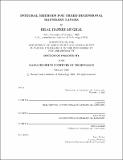| dc.contributor.author | Mughal, Bilal Hafeez | |
| dc.date.accessioned | 2010-08-27T18:54:02Z | |
| dc.date.available | 2010-08-27T18:54:02Z | |
| dc.date.issued | 1998-02 | |
| dc.identifier.uri | http://hdl.handle.net/1721.1/57588 | |
| dc.description.abstract | Several distinct issues important in integral approximations of the three-dimensional boundary-layer equations are addressed. One of these is the requirement, justified on the basis of the nature of the full differential equations, for hyperbolicity of integral equation systems. It is generally not feasible to analytically determine the mathematical character of these systems, except in very simple cases, because of the empiricism necessary for closure. Furthermore, the use of general systems is inhibited because there is no guarantee that they are hyperbolic. A novel method accommodating the role of both equations and closure, so that systems are always hyperbolic with physically-consistent characteristic directions, is proposed. Another issue considered is the calculation of bidirectional crossflows for which a well-conditional system, for use in Newton solvers, is devised. The validity of this system is demonstrated by comparing results with a numerical solution of the full differential boundary-layer equations for the case of an infinite-swept wing. Finally, a fully-simultaneous scheme coupling inviscid flow, calculated using a simple Panel method, to general integral systems is devised with the facility to use empirical closure parameters as system parameters. The coupling scheme is demonstrated by computing the separated flow downstream of a smooth obstacle. For calculations, the equations are posed in conservation form in local Cartesian coordinates and discretized using the finite-element method. Unlike dissipation schemes used in previous methods, a Petrov-Galerkin streamline upwinding weight function, adapted heuristically for the coupled equation system, is used to control spurious oscillations. | en |
| dc.description.sponsorship | Support was given by the Boeing Company, with Dr. Wen-Huei Jou and Dr. Forrester Johnson as the Technical Monitors. | en |
| dc.language.iso | en_US | en_US |
| dc.publisher | Aerospace Computational Design Laboratory, Dept. of Aeronautics & Astronautics, Massachusetts Institute of Technology | en_US |
| dc.relation.ispartofseries | ACDL Technical Reports;FDRL TR-97-7 | |
| dc.title | Integral methods for three-dimensional boundary layers | en_US |
| dc.type | Technical Report | en_US |
